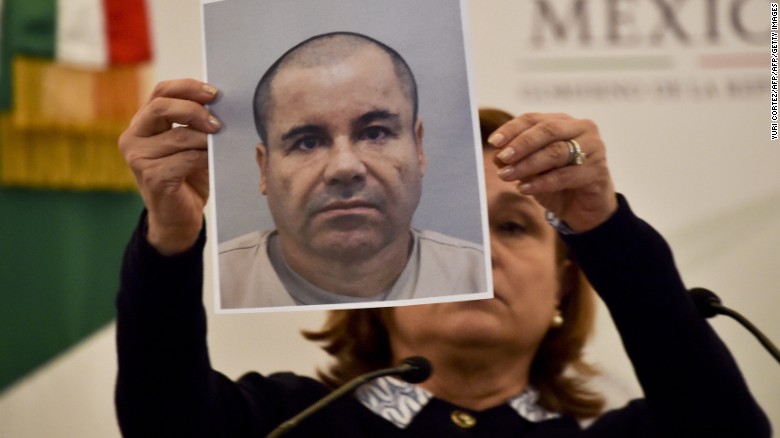
Mexico will begin proceedings to extradite two-time prison escapee Joaquin “El Chapo” Guzman Loera to the United States, where he faces drug trafficking charges connected to his cartel, the Mexican attorney general said Saturday.
“Since Guzman Loera has been recaptured, the beginning of the extradition proceedings should begin,” the attorney general’s office said in statement.
Mexican Attorney General Arely Gomez noted how the U.S. government sought Guzman’s extradition as early as June 16, before he escaped for a second time from a Mexican prison in July.
The announcement settles a big question surrounding Guzman since Mexican authorities recaptured him on Friday: Would Mexico try to imprison the notoriously elusive kingpin for a third time — and risk further international embarrassment if he were to escape again? The answer is no.
While on the run the past six months, the notorious outlaw thought about one thing: a movie about himself.
Contact with filmmakers
It amounted to hubris: His vanity helped authorities in recapturing him. Now he faces extradition to a country whose maximum security prisons are unbreakable.
Police and the military successfully hunted down Guzman and his henchmen this week partly because he or his representatives contacted filmmakers about making an El Chapo biopic, Attorney General Gomez said.
“Another important aspect that allowed us to pinpoint his location was having discovered Guzman Loera’s intention to film a biographical movie through establishing communication with actors and producers, which formed a new line of investigation,” Gomez said.
Hollywood will likely make a movie or even a series about El Chapo, as it has about other drug lords, such as Colombia’s Pablo Escobar in “Narcos.”
But for now, Guzman won’t have a direct hand in any.
His efforts to develop a biopic ends in a scene with an interesting twist: After six months on the lam, Guzman is now back in the same maximum security prison from which he escaped, according to a Mexican law enforcement official with knowledge of the case.
Surveillance helps in recapture
The tracking of communications including cell phones and electronic exchanges involving people close to Guzman was critical in his recapture, according to two U.S. law enforcement officials.
“It was the same apparatus that caught him last time, staying tight on the people around him,” one of the officials said.
The United States shared intelligence with Mexican authorities, but the actual operation was all done by the Mexicans, the U.S. officials said.
In July, Guzman used an elaborate underground tunnel to break out of a Mexican federal prison.
But he was recaptured Friday after the Mexican navy raided a home in the coastal city of Los Mochis in his native state of Sinaloa, where he enjoyed protection from his gunmen and many local residents who revered him as a modern Robin Hood.
Guzman’s prison escape — his second in 14 years — embarrassed the Mexican government and became a symbol of its corruption.
Now that Guzman is back inside the Altiplano maximum security prison in central Mexico, officials aren’t disclosing where exactly he is being held inside the facility.
Chase through sewer tunnels
The home where he was recaptured Friday had been under surveillance for a month, the attorney general said.
Guzman arrived at the house Thursday, and authorities raided it in the wee hours of Friday.
When the Mexican navy arrived, they encountered gunfire from inside, according to Gomez. The navy said five suspects died and six others were arrested. One navy personnel was injured.
During the shootout, Guzman and an aide allegedly escaped through a manhole that led to the city’s sewer system.
Soldiers chased him through the sewer tunnels, but he made it to the surface, where he stole a car, authorities said.
He almost got away, but authorities located the car on a highway outside the city and nabbed him.
Some of Guzman’s alleged accomplices have been detained as well.
In the July prison break, the man in charge of building the escape tunnel underneath the prison has already been arrested, along with the owner of the land over the tunnel. So was an attorney who allegedly paid for the tunnel, as was Guzman’s brother-in-law, authorities added.
Massive manhunt
In that July escape, Guzman disappeared after stepping into the shower. He slipped through a hole in his cell block and into a tunnel that was lighted and ventilated.
From there, he took off for San Juan del Rio, where two small planes awaited, Gomez said. Two pilots were among the dozens of people arrested.
In the hunt for Guzman, there were reported sightings and near-misses. In October, authorities said they were hot on his trail, only to have him slip out of sight, though not before apparently breaking his leg.
After his capture this week, a relieved President Enrique Peña Nieto applauded security forces.
“Mission accomplished: We have him,” he tweeted.
Veteran cartel
The Sinaloa state native started his drug cartel in 1980. He became a powerful figure, leading a multibillion-dollar empire that supplied much of the marijuana, cocaine and heroin sold on American streets.
U.S. indictments claim the organization used assassins and hit squads to show its muscle.
Authorities first arrested Guzman in Guatemala in 1993. They extradited him to Mexico. After his conviction, he went to the Puente Grande maximum security prison.
But in 2001, he escaped using a laundry cart. He evaded Mexican authorities for years.
His freedom ended in 2014, when he was arrested in the Mexican resort town of Mazatlan.
Guzman was then sent to Altiplano Federal Prison in Almoloya de Juarez, where he successful made another daring escape last summer.
But on Friday night, authorities paraded him before the media as their big catch. They later put him on a helicopter, ferrying him back to the same prison.
As reported by CNN
